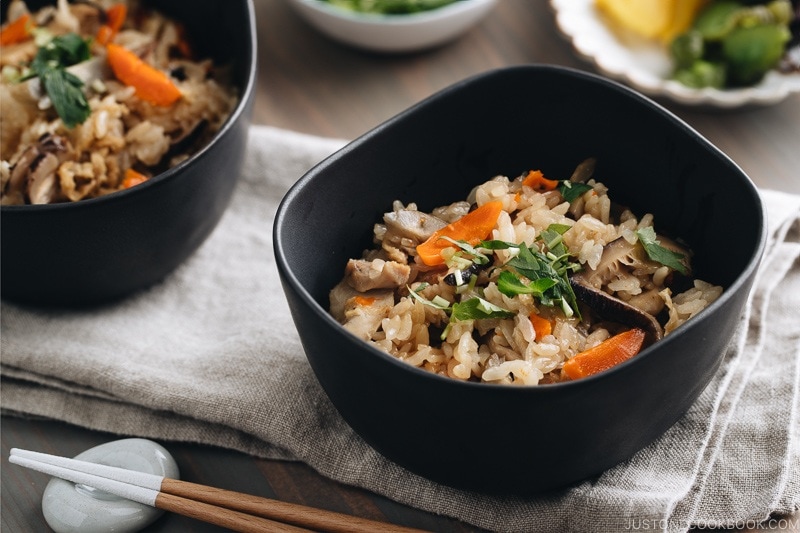Instant Pot Takikomi Gohan
4.4
(36)
Your folders
Your folders
Prep Time: 35 minutes
Cook Time: 25 minutes
Total: 60 minutes
Servings: 4
Author : Namiko Chen

Ingredients
Export 11 ingredients for grocery delivery
Instructions
Step 1
Gather all the ingredients. Make dashi if you don’t have it around already and let it cool to room temperature (you can place the pot with dashi in it over a bowl of iced water).
Step 2
In a large bowl, measure and add 2 rice measuring cups (360 ml). Rinse the rice under cold water, by gently rubbing the rice with your fingertips in a circling motion. Submerge the rice in water and pour out the starchy water. Rinse and repeat until the water becomes clear. Soak rice in water for 20-30 minutes. Meanwhile, start preparing the ingredients.
Step 3
Here's how the rice looks before and after soaking for 20 minutes. Drain water completely. Set aside for 10 minutes. If you don’t have time to wait, then shake off the excess water the best you can.
Step 4
In a small bowl, add dried shiitake mushrooms and ¼ cup water. Put a heavy object on top so the shiitake mushrooms will be submerged under water. Let them soaked till tender or while you prep other ingredients.
Step 5
Cut the chicken thigh into slanted, smaller bite-sized pieces. I use “Sogigiri” Japanese cutting technique to create more surface so it will cook faster. Add ½ Tbsp sake to remove any unwanted smell from the chicken.
Step 6
Peel gobo skin with the back of a knife. You don’t use a vegetable peeler to peel gobo’s skin because the earthy delicious flavor is just right below the skin and you don’t want to peel it off. Cut the gobo in half lengthwise.
Step 7
Thinly slice each half diagonally. Soak the gobo in water to prevent it from turning brown and to remove any astringent taste.
Step 8
Cut the carrot in half lengthwise and thinly slice diagonally.
Step 9
Pour hot water over aburaage to get rid of the excess oil. Some people skip this step as the oil is cleaner these days. I do it anyway. Cut in half lengthwise.
Step 10
Cut the tofu pouch into thin slices and squeeze water out.
Step 11
Roughly, you will need ⅓ cup each of sliced carrot, sliced gobo, and sliced aburaage.
Step 12
By now shiitake mushrooms should be hydrated and tender. Squeeze them to remove the excess liquid in the bowl. We will use this reserved liquid “Shiitake Dashi”. Remove the stem from each shiitake mushrooms.
Step 13
Thinly slice the mushrooms. If it’s a big mushroom, cut the slices in half.
Step 14
In a 2-cup measuring cup, add 2 Tbsp shiitake dashi (the reserved liquid from hydrating shiitake mushrooms). If you are worried about small particles that are left in the liquid, you can strain the liquid using a tea strainer. Then in the same measuring cup, add 1 ½ Tbsp soy sauce, 1 Tbsp mirin, and ½ tsp salt.
Step 15
Lastly, add dashi so that the seasoning is 360 ml.
Step 16
In a large bowl, add chicken, shiitake mushrooms, carrot, gobo, aburaage, and the seasoning from the previous step. Mix well.
Step 17
Transfer drained rice and make sure the rice is evenly distributed and flat.
Step 18
Add the ingredients and seasoning liquid on top of the rice. DO NOT MIX rice and the ingredients. Try to evenly distribute the ingredients and flatten without mixing with rice.
Step 19
Close the lid and click MANUAL. Set HIGH pressure for 2 minutes.
Step 20
Make sure the steam release handle points at “sealing” and not “venting.” The float valve goes up when pressurized (it takes roughly 10 minutes to pressurize).
Step 21
When it’s finished cooking, the Instant Pot will beep and switch automatically to the “Keep Warm” mode. Let the pressure release naturally for 10 minutes (10-minute natural release) and then proceed with a quick release by turning the steam release handle to the “venting” position to let steam out until the float valve drops down. DO NOT EXCEED MORE THAN 10 MINS. I recommend setting a timer. When you do a quick release, hold a kitchen towel and do not place your hand or face over steam release valve. The steam should be left only a little bit after 10 minutes of natural release.
Step 22
Fluff the rice with a rice scooper immediately to avoid burning the rice on the bottom. Instead of “mixing”, try to “cut” the rice at a 45 degrees angle as you fluff.
Step 23
Cut the mitsuba into small pieces. If you don’t have mitsuba, you can use green onion.
Step 24
Serve Takikomi Gohan in individual bowls and garnish with mitsuba.
Step 25
The best way to store Japanese rice is to freeze, even if you use it the following day. Read this post.